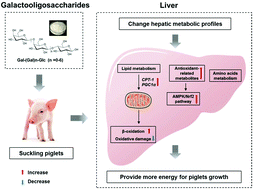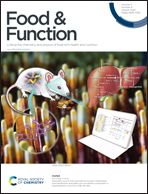Early galactooligosaccharide intervention alters the metabolic profile, improves the antioxidant capacity of mitochondria and activates the AMPK/Nrf2 signaling pathway in suckling piglet liver†
Abstract
The suckling stage is a critical window time for the development of human and animal neonates. Our previous study found that an early-life galactooligosaccharide (GOS) intervention could improve the growth status of suckling piglets; however, the difference in the metabolic status between different treatment groups still remains unclear. In the present study, sixty neonatal piglets were used to investigate the effects of early-life GOS intervention on the hepatic metabolic profiles of piglets. In the first week after birth, the piglets in the GOS and control (CON) groups were fed with GOS solution (10 mL for 1 g per kg body weight per day) and physiological saline, respectively. On days 8 and 21, six piglets from each group were euthanized for sampling. Compared with the CON piglets, the GOS piglets showed a lower total serum cholesterol concentration on day 8, but a higher concentration of serum HDL-C and albumin on day 21. Principal component analysis and partial least-squares discriminant analysis showed a dramatic difference in the composition of hepatic metabolic profiles between the two groups. The GOS intervention mainly affected the lipid and amino acid metabolism of the piglets. Meanwhile, the mRNA levels of CPT-1 and PCG1α increased in the GOS piglets’ liver. Additionally, with the accumulation of antioxidant-related metabolites in the GOS piglet liver, the hepatic mitochondrial antioxidant capacity increased, and the phosphorylation of AMP-activated protein kinase and the protein expression levels of nuclear factor-erythroid-2-related factor 2 and heme oxygenase-1 were also upregulated in the liver. In conclusion, our findings provide new insights into the effects of galactooligosaccharides on the growth of suckling piglets.



 Please wait while we load your content...
Please wait while we load your content...